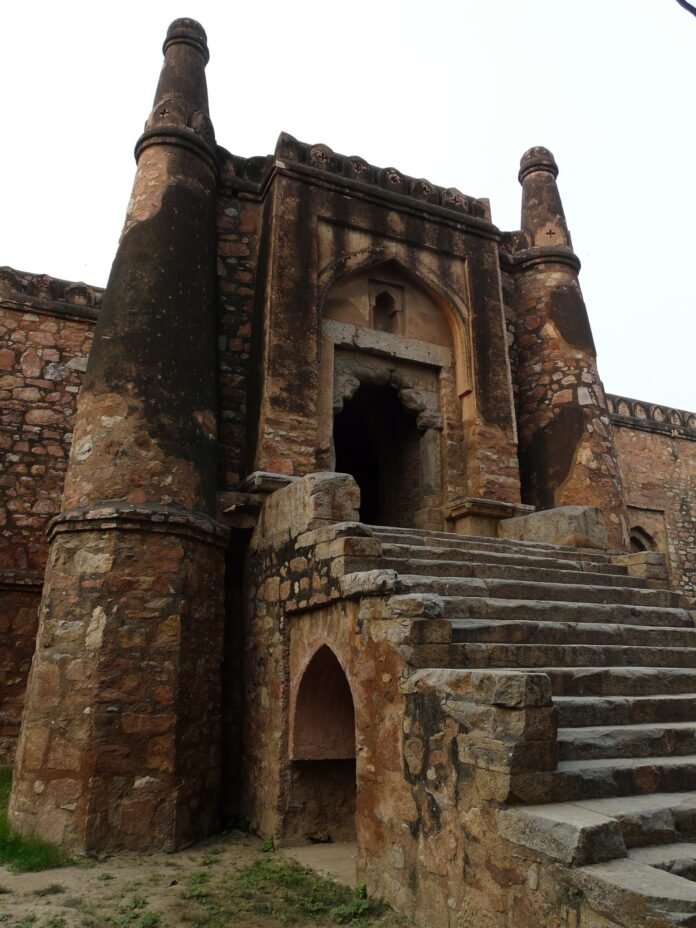
Nestled in the heart of Saket’s dense high-rise housing complexes, Khirki Masjid stands as a remarkable testament to the Tughlaq dynasty’s architectural prowess. Finding this hidden gem amidst the labyrinth of narrow lanes is no small feat—without Google Maps, locating this mosque is nearly impossible. Even the locals seemed unaware of its existence, a testament to how concealed this monumental structure has become.
Khirki Masjid is a stark reminder of the juxtaposition between the old and new in Delhi. Unlike many other archaeological sites plagued by unplanned encroachments, Khirki Masjid is surrounded by towering residential blocks that seem to dwarf this historical fortress-like structure. This unique contrast makes it one of the most intriguing sites in India.
Commissioned by Khan-i-Jahan Malik Juna Shah Tilangani, the mosque was designed during the reign of Sultan Feroz Shah Tughlaq (1351-1388). Malik Juna Shah, unlike his father, devoted his time to construction, leaving behind a legacy of seven magnificent mosques in Delhi, including Khirki Masjid. The other mosques are Begumpur Mosque, Masjid Kalu Sarai, Kalan Masjid (Hazrat Nizamuddin), Masjid Firoz Shah Kotla, Masjid Wakya (Lahori Gate), and Kalan Masjid (Turkman Gate).
Of these, Khirki Masjid is arguably the most striking. The mosque is set on a 3-meter high raised plinth and is square in plan, measuring 52 meters on each side. It features projecting entrances on the north, east, and south sides, each framed by narrow minarets. The structure is reinforced by massive round towers at each corner. The roof is divided into a grid of 25 squares, 21 of which are covered by nine conical domes, while the remaining four squares are open to the air, creating mini courtyards. This design makes Khirki Masjid the first mosque in India to feature such extensive roofing over its internal space.
The mosque’s name, “Khirki,” meaning “window,” is derived from the grid-patterned windows on its three exterior sides. These windows, twelve on each side, were designed to compensate for the lack of light entering the mosque from above. The current ground level around the mosque is significantly higher than it was in 1370, creating a moat-like appearance due to the buildup of surrounding domestic habitation over centuries.
The site is enclosed by a tall wire fence to prevent further encroachment and unauthorized access.
Inside, the mosque is a geometric marvel, with 180 columns arranged in a regular grid-like plan, creating endless photogenic views. However, photographing the interior proved challenging due to the lack of available light. Despite traveling with a tripod, often leave it behind on days out, as they are frequently not permitted at ASI sites. This visit was an exception, and people generally regret not having tripod to capture the grandeur of the interior adequately.
The darkest areas of the mosque are the bays in front of the prayer wall (mihrab), where roosting bats can often be found. Despite these challenges, the mosque’s interior is awe-inspiring and warrants a longer visit, particularly once the ASI renovations are complete. Visitors should note the steps leading to the roof from the eastern gate, offering a different perspective of the structure.
The ASI’s renovation work at Khirki Masjid has not been without controversy. A mistake in the preparation of lime mortar resulted in a pinkish hue in treated areas. The original method involved burning lime in a kiln, submerging it under water for a month, and then grinding it with sand. The change in ingredients altered the mortar’s properties and increased costs. Following this mistake, renovations were suspended, and the ASI held workshops to educate staff on proper restoration techniques for Mughal monuments.
Khirki Masjid has also made headlines for archaeological discoveries. In 2018, the ASI found a hoard of 254 copper coins in a clay pot near the entrance stairs. The coins dated back to the mid-16th century, with some from the Lodi period, suggesting they may have represented the savings of a family over generations. A similar discovery occurred in 2003, when 63 coins were found during pre-conservation cleaning activities.
The Khirki Masjid experience was a highlight of exploration of less-visited sites in Delhi. This hidden gem, surrounded by urban sprawl, deserves more recognition and public attention. The nearby site of Satpula is also worth visiting, adding to the allure of this historical area.
In summary, Khirki Masjid is a fascinating paradox of past and present, offering a unique glimpse into Delhi’s rich architectural heritage amidst modern urban development.

